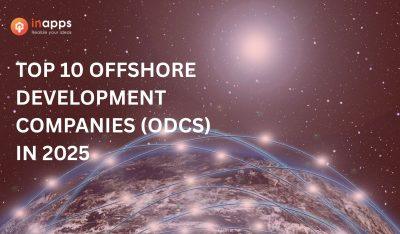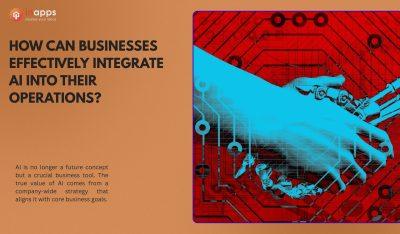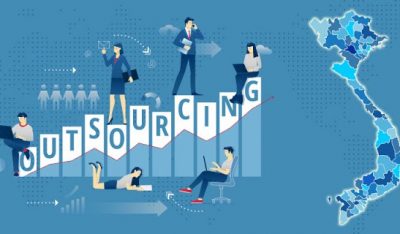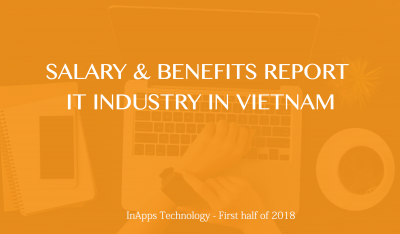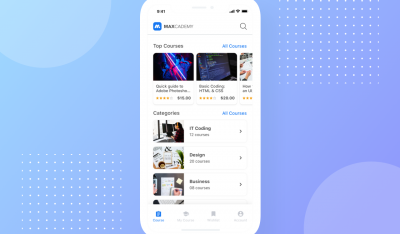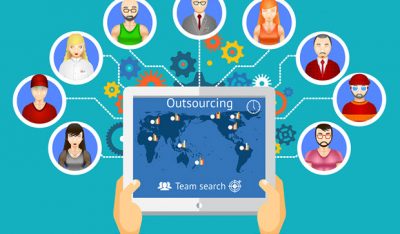- Home
- >
- Offshore News
- >
- Agile vs Waterfall methodology: Which is better?
Agile vs Waterfall are the two most popular project management methodologies. Both are widely used in software development, but each will be suitable for different projects. When choosing between Waterfall and Agile, there are various aspects to consider. This article will make all things clear.
To assist your development team in determining when to employ Agile vs Waterfall software development, we’ll walk you through the benefits and drawbacks of these two standard methods, as well as the situations where one may be preferable to the other.
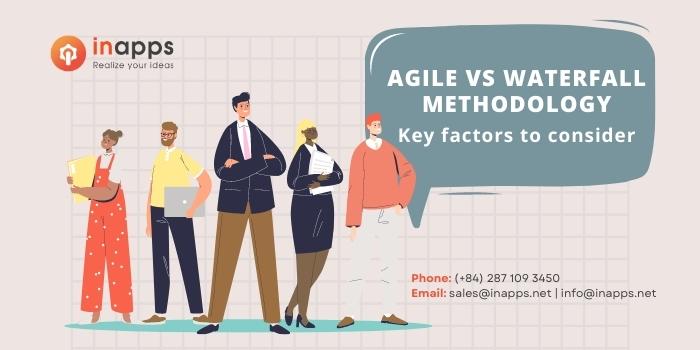
What is Waterfall methodology? What is Agile methodology?
Key Summary
- Overview: The article compares Agile and Waterfall methodologies for software development, evaluating their processes, benefits, and suitability to help businesses choose the best approach. InApps Technology highlights Vietnam’s role as a cost-effective hub for implementing these methodologies.
- What are Agile and Waterfall Methodologies?:
- Agile: An iterative, flexible approach with short sprints (2–4 weeks), emphasizing collaboration and adaptability, delivering 100+ incremental updates.
- Waterfall: A linear, sequential process with distinct phases (e.g., requirements, design, coding), completing 100% of each before progressing.
- Context: In 2022, 71% of companies used Agile, while 10% relied on Waterfall (Standish Group), reflecting Agile’s dominance but Waterfall’s niche relevance.
- Key Comparison Points:
- Flexibility and Adaptability:
- Agile: Highly flexible, allowing 80% of requirement changes mid-project. Sprints enable 50+ adjustments based on client feedback.
- Waterfall: Rigid, with <10% scope for changes once started. Fixed requirements suit 90% of stable projects.
- Verdict: Agile excels for dynamic needs; Waterfall for fixed scopes.
- Example: Agile pivots a 100K-user app’s features in 2 weeks; Waterfall locks a banking system’s specs for 6 months.
- Project Timeline and Delivery:
- Agile: Delivers working software every 2–4 weeks, supporting 100+ iterations. Ideal for 70% of projects needing early releases.
- Waterfall: Delivers complete product after 6–12 months, with 100% of features at once. Suits 20% of long-term projects.
- Verdict: Agile for rapid delivery; Waterfall for comprehensive rollouts.
- Example: Agile releases a SaaS MVP in 1 month; Waterfall completes an ERP in 9 months.
- Cost Management:
- Agile: Flexible budgets, adjusting 50% of costs per sprint. Total cost ($100K–$1M) varies with 100+ iterations.
- Waterfall: Fixed budgets ($200K–$2M), with 90% cost predictability. Overruns occur in 15% of projects due to late issues.
- Verdict: Agile for evolving budgets; Waterfall for fixed funding.
- Example: Agile scales a $500K app with 10 sprints; Waterfall budgets $1M upfront.
- Team Collaboration and Client Involvement:
- Agile: High collaboration, with 100+ daily stand-ups and 80% client input per sprint. Involves 10–50 team members.
- Waterfall: Limited interaction, with client input at 2–3 milestones. Teams of 20–100 work in silos per phase.
- Verdict: Agile for client-driven projects; Waterfall for independent teams.
- Example: Agile’s daily client calls refine 50 app features; Waterfall gathers requirements once for a 1M-user system.
- Risk Management:
- Agile: Mitigates risks early via 100+ sprint reviews, catching 80% of issues pre-release. 10% risk of scope creep.
- Waterfall: Risks surface late, with 30% of bugs found in testing. 20% chance of major rework.
- Verdict: Agile reduces risks; Waterfall risks late failures.
- Example: Agile fixes 100 bugs in sprints; Waterfall delays 50 fixes to testing.
- Suitability for Project Types:
- Agile: Best for 100+ innovative, uncertain projects (e.g., startups, SaaS). Adapts to 80% of market changes.
- Waterfall: Suits 50+ regulated, stable projects (e.g., government, banking). Meets 90% of compliance needs.
- Verdict: Agile for flexibility; Waterfall for predictability.
- Example: Agile builds a 100K-user app; Waterfall delivers a compliant banking platform.
- Flexibility and Adaptability:
- Choosing the Right Methodology:
- Agile: Ideal for startups, tech firms with 100K–1M users, or projects needing 50+ iterations and client feedback.
- Waterfall: Best for enterprises with fixed $1M+ budgets, regulated industries, or 100% defined requirements.
- Hybrid: Combines Agile sprints with Waterfall planning for 30% of mid-sized projects, balancing 50+ features and compliance.
- Data: Agile had 60% higher success rates (Standish Group 2022); Waterfall suited 20% of legacy systems.
- Benefits of Agile and Waterfall:
- Agile: 30% faster delivery, 80% client satisfaction, 50% fewer late-stage bugs.
- Waterfall: 90% predictable timelines, 100% compliance for regulated apps, 20% lower scope creep.
- Both: Deliver 100K–1M user apps with structured processes.
- Cost Efficiency: Offshore development in Vietnam ($20–$50/hour via InApps) saves 20–40% vs. U.S./EU ($80–$150/hour).
- Quality: Achieve 95% user satisfaction with right methodology.
- Challenges:
- Agile: 15% risk of scope creep, 20% more coordination for 50+ stakeholders.
- Waterfall: 30% risk of late bugs, 25% inflexibility for 100+ feature changes.
- Both: Aligning 100+ team members takes 10% effort; 15% budget overruns possible.
- Security Considerations:
- Data Protection: Use AES-256 for project data, TLS for communications.
- Compliance: Agile and Waterfall meet GDPR, SOC 2 for 1M+ user apps.
- Access Control: MFA for 100% of tools (e.g., Jira, Azure DevOps).
- Example: InApps secures Agile workflows with MFA, meeting SOC 2 standards.
- Use Cases:
- Agile: SaaS platforms, e-commerce apps with 100K+ users, startup MVPs.
- Waterfall: Banking systems, government software, 1M+ user ERPs.
- Hybrid: Mid-sized firms with 50K–500K users needing 50+ features and compliance.
- InApps Technology’s Role:
- Leading HCMC-based provider with 488 experts in Agile, Waterfall, and software development.
- Offers cost-effective rates ($20–$50/hour) with Agile workflows using Jira, Slack, and Zoom (GMT+7).
- Specializes in tailoring methodologies, delivering 100+ projects with tools like Azure DevOps, Kubernetes, and Snyk.
- Example: InApps develops an Agile-based SaaS app for a U.S. client, delivering 50 features in 3 months.
- Recommendations:
- Use Agile for 100+ flexible, client-driven projects with rapid iterations.
- Choose Waterfall for 50+ stable, regulated projects with fixed scopes.
- Consider hybrid for 30% of projects balancing 50+ features and compliance.
- Partner with InApps Technology for cost-effective development, leveraging Vietnam’s talent pool.
1. Waterfall vs Agile methodology: What is Waterfall?
Waterfall project management is a conventional methodology for designing engineering solutions that were developed originally for projects in the manufacturing and construction industries.
When it comes to software development, specific activities accomplished in one phase must be examined and confirmed before going on to the next. It is a sequential and linear strategy in which stages flow downward (waterfalls) to the next.
1.1 Pros of Waterfall
Let us now look at some of the advantages and disadvantages of implementing this software development methodology.
More disciplined design:
Because each phase has distinct start and finishes points, developers must accomplish all tasks in each stage so that the project may go ahead.
Clearly defined deadlines:
Due to the Waterfall model’s static nature and predictable procedures, it is simpler to set clearly defined deadlines, estimate expenses, and develop timelines.
Well-documented approach:
The waterfall is preferred by many firms because it necessitates detailed documentation for each development step. This makes it simple to examine the rationale behind previous efforts while also providing the groundwork for future software development projects.
Clear communication:
Because development stages are well-documented and predictable, developers may provide progress updates to stakeholders, clients, or top management.
Easier learning curve:
Because the Waterfall model was the standard way for managing projects in most sectors, most teams will not require prior training or experience to begin a project utilizing this strategy. Furthermore, because clients and developers agree on project parameters early on, designing and planning are considerably more manageable.
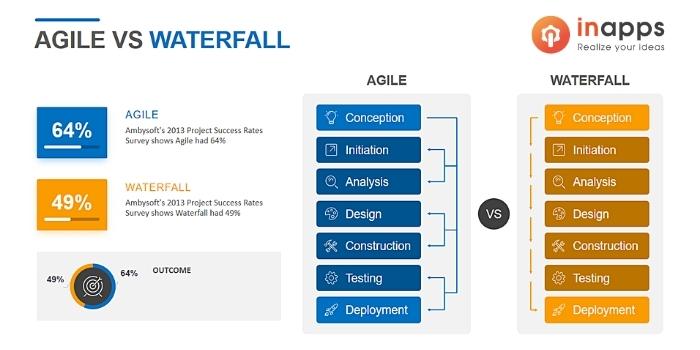
Waterfall methodology vs Agile
1.2 Cons of Waterfall
Gathering project requirements too early may be dangerous:
In most cases, customers and other stakeholders are unsure of what they want until they have spent time with a prototype. Because the Waterfall process entails managing all needs upfront, there is a significant chance of obtaining incorrect data, which may create several issues later in the development phases.
Making adjustments is exceedingly expensive:
The biggest downside of the Waterfall method’s rigidity is its severely limited capacity to handle change. The testing is performed too late in the software’s life cycle, so it will be too late to make adjustments and pivot if people do not like the app you are developing.
Prolonged project delivery times:
Before developers begin coding, they must complete many developmental steps. This means that clients and stakeholders will not see a prototype or a functional outcome until the project is nearing the end of its life cycle.
The propensity to neglect to test:
It is pretty dangerous to undertake all of the rigorous tests once the project is almost finished, owing to the temptation of speeding through it, especially while working with tight deadlines. The fact is that inadequately tested products may lead to a disastrous launch, and developers will also lose important data and input that might have been used earlier in the project’s life cycle.
1.3 Waterfall development process
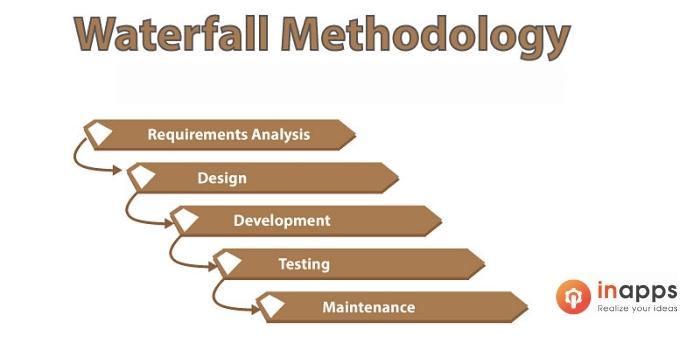
Waterfall development process
Each organization will generally have its own set of phases for the Waterfall model; however, the method may look something like this:
| Stage | Action |
| Conception | The conception stage is where developers decide on an idea and what they want to produce. It will progress to a cost/benefit analysis and conclude with a project estimate. |
| Initiation | The goal of the initiation phase is to collect and record what the project will require, including software and system requirements. When you hire team members, you broaden the scope of the assignment with purpose, deliverables, and objectives. |
| Analysis | The next step is to conduct feasibility tests to develop more precise requirements specification paperwork. |
| Design | During the design phase, designers create storyboards, mockups, and wireframes to help them visualize the project. They study and assess the requirements, establish team goals, and create an action plan, resulting in defined software architecture. |
| Coding or Construction | The fundamental software development activity occurs. This step entails the coding of each component of the software. The developers begin developing the app based on the designs and techniques agreed upon earlier in the process. |
| Testing | The produced software is thoroughly tested to ensure no flaws. This stage often entails further coding to address any software’s source code issues. It will also feature UAT testing, in which end-users will test the software before it is released. |
| Implementation | The completed product is released to the market for user use. |
| Maintain and Upgrade | No program is flawless, and users will almost certainly face issues as they utilize the new software. The developers must put in place a support mechanism to deal with any problems resulting from updates and bug fixes. The patches can even be utilized to introduce new functionality to stay competitive. |
2. Waterfall vs Agile methodology: What is Agile?
Agile methodology is a form of an incremental approach to software development based on ideas that place a greater emphasis on: people, outcomes, collaboration, and adaptability to change.
Instead of designing the entire project, it breaks it down into small parts in iterations or short time limits. Each iteration comprises all SDLC phases, resulting in a functional product at the end. A new or revised product is released after multiple revisions.
2.1 Pros of Agile
Flexibility:
Because of the short and timely development cycles, the software development project has more flexibility to adjust to client changes as necessary.
Real-time input:
Real-time feedback throughout development guarantees that you produce products that users demand.
Test-driven software development:
By dividing the project into iterative pieces, developers have more excellent room and time to construct more detailed unit tests to assess individual functionality in the minimal viable product.
Faster and higher-quality delivery:
Because tests are performed after each iteration, you will receive higher-quality releases with fewer defects. This solid foundation helps to quicker and higher-quality software releases in subsequent iterations.
Emphasis on teamwork:
The agile technique entails regular cross-team contact pair programming and draws on all team members’ strengths.
2.2 Cons of Agile
Uncertain timelines:
The agility of Agile development may allow for some delay. Furthermore, because tasks are often produced and reprioritized with each app iteration, the entire delivery timeframe is pushed farther into the future.
Requires a high level of commitment:
Agile works best when every team member is dedicated to working on the project. This is because it requires team participation and daily meetings, which can take a significant amount of time compared to the Waterfall technique.
The possibility of increasing costs:
While Agile springs allow for better planning, particular deliverables are unlikely to be delivered on time. Creating the necessary extra sprints may thus result in higher project expenses for the customer.
Communication:
Because Agile needs far higher levels of cooperation, development teams and clients will need to be in frequent touch, which might be difficult for remote work.
2.3 Agile development process
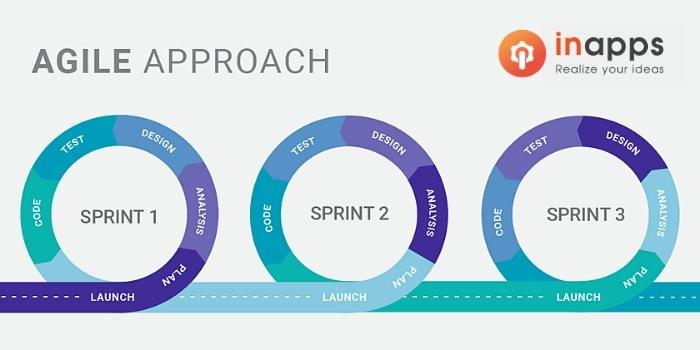
Agile development process
Here are a few core principles of Agile development methodology:
| Agile principles | How it works |
| High Adaptability | The Agile methodology emphasizes the benefits of having the freedom to modify requirements, architecture, deliverables, and design during the project development process. Compared to the prior Waterfall method, it is naturally a more flexible software development technique. |
| Customer Involvement | Because of the rapid changes in design and deliverables, Agile necessitates strong collaboration between developers and consumers. This entails guaranteeing high client satisfaction with the MVPs and receiving ongoing feedback. |
| Lean Software Development | Agile development aims to make the end product as simple as feasible. This entails using the most straightforward actions to produce high-quality outcomes. As a result, the engineers decreased the complexity and bloat that may substantially impact performance. It involves identifying and deleting any aspects that bring value to the process. |
| Teamwork | Agile recognizes the benefits of working in groups. Agile teams must collaborate and constantly assess how they might grow and become more efficient. |
| Sustainability | Agile development focuses on establishing a more sustainable development pace rather than pressuring developers with tighter deadlines and getting incomplete deliverables. |
| Testing | Unlike the Waterfall approach, which has a separate testing step, Agile includes testing at all project stages. Agile’s short sprints involve continuous testing, and developers must regularly offer ongoing input on the project’s quality. |
3. What is the difference between Waterfall vs Agile?
The main distinction between Waterfall vs Agile is a linear style of working that requires the team to finish each project phase before going on to the next one. In contrast, Agile encourages the team to concurrently work on several project stages.
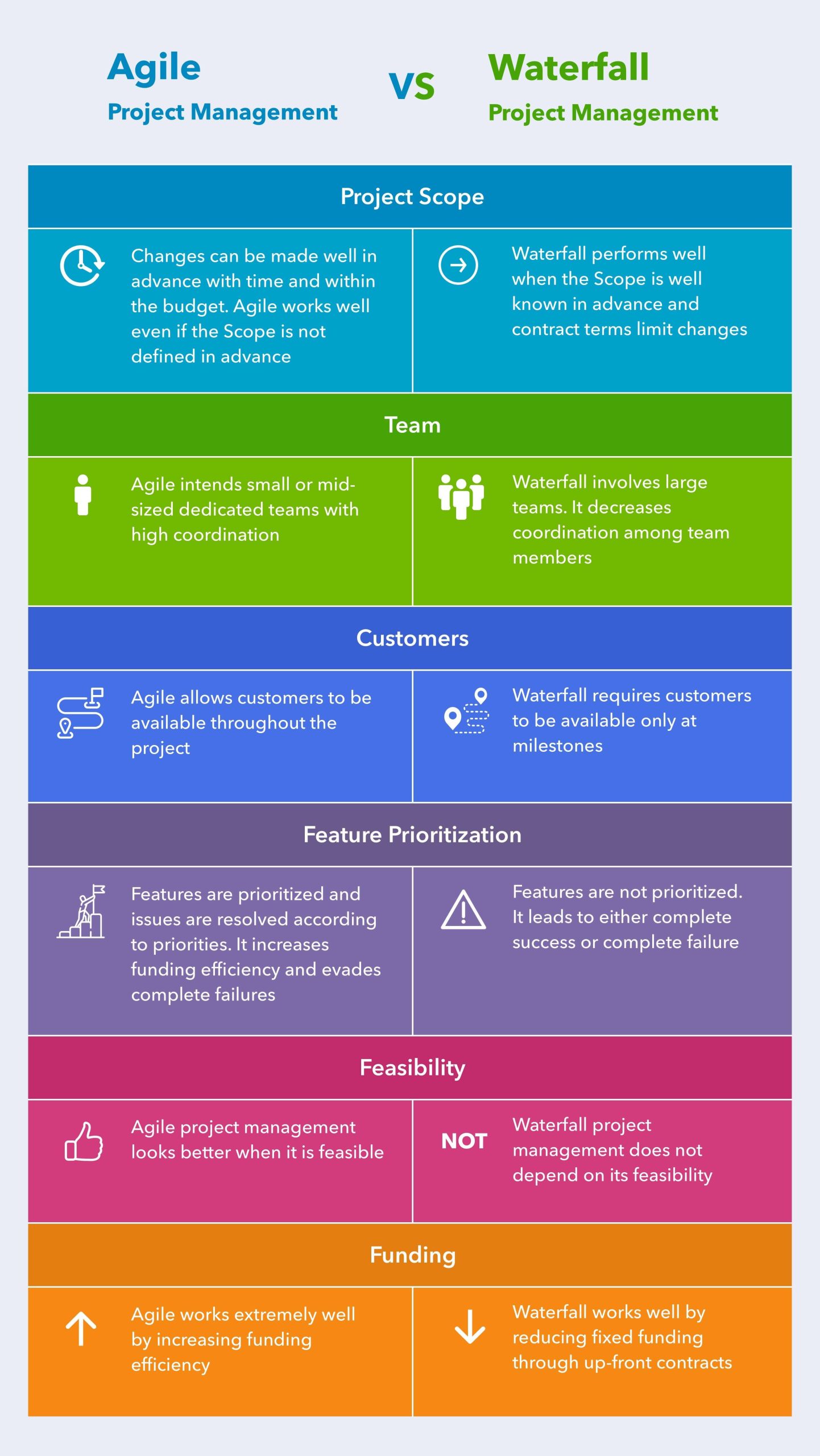
Agile vs waterfall
4. Which is better: Agile vs Waterfall
Waterfall software development is best suited for projects with specific deadlines and deliverables. The waterfall method is generally the best strategy if your primary project limitations are fully known and documented.
Agile development is best suited for projects whose major limitations are not recognized. If your project includes creating a new product, determining the scope and timing ahead of time may be challenging. It is adaptable, allowing you to design a project in stages or “sprints” that can change as the work advances.
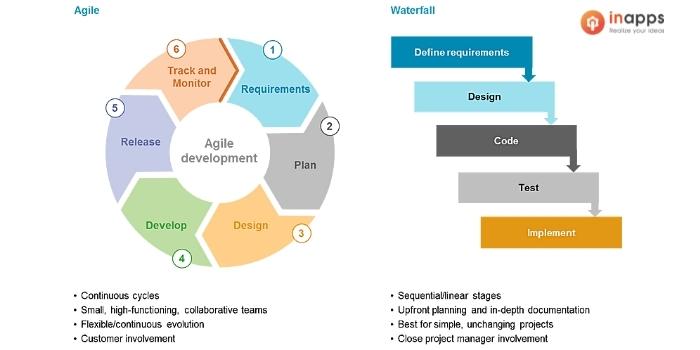
Agile versus Waterfall: Difference between Waterfall and Agile
Agile vs Waterfall methodology: Conclusion
On the one hand, there is the typical Waterfall software development strategy, in which the project is handled sequentially with various events from conception through production.
On the other hand, the contemporary Agile method entails adaptable, iterative, team-centered development. While both development techniques aim to aid in the simplification of the process of managing software development jobs, they operate in quite different ways.
Both Waterfall and Agile have significant strengths and limitations, as seen above. Finally, deciding between these techniques boils down to choosing stability and adaptability. Regardless of which development model is more traditional or popular, a company’s selection on which development model to utilize must ultimately be based on specific goals, clients, teams, and project demands.
I hope this article on Agile vs Waterfall methodology helps you. If you need to find a trusted Agile team for your project, InApps is here to help.
Let’s create the next big thing together!
Coming together is a beginning. Keeping together is progress. Working together is success.





